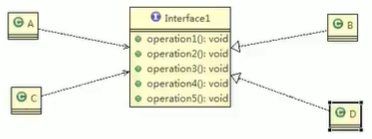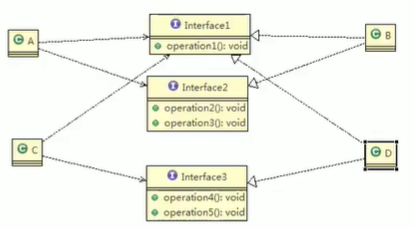介面隔離原則(Interface Segregation Principle): 1、客戶端不應依賴它不需要的介面 2、類間的依賴關係應該建立在最小的介面上 其實通俗來理解就是,不要在一個介面裡面放很多的方法,這樣會顯得這個類很臃腫。介面應該儘量細化,一個介面對應一個功能模塊,同時介面裡面的方法應該 ...
目錄:
介面隔離原則(Interface Segregation Principle):
1、客戶端不應依賴它不需要的介面
2、類間的依賴關係應該建立在最小的介面上
其實通俗來理解就是,不要在一個介面裡面放很多的方法,這樣會顯得這個類很臃腫。介面應該儘量細化,一個介面對應一個功能模塊,同時介面裡面的方法應該儘可能的少,使介面更加靈活輕便。或許有的人認為介面隔離原則和單一職責原則很像,但兩個原則還是存在著明顯的區別。單一職責原則是在業務邏輯上的劃分,註重的是職責。介面隔離原則是基於介面設計考慮。例如一個介面的職責包含10個方法,這10個方法都放在同一介面中,並且提供給多個模塊調用,但不同模塊需要依賴的方法是不一樣的,這時模塊為了實現自己的功能就不得不實現一些對其沒有意義的方法,這樣的設計是不符合介面隔離原則的。介面隔離原則要求"儘量使用多個專門的介面"專門提供給不同的模塊。
經典案例:
類A通過Interface1依賴類B,1,2,3;類B通過Interface1依賴D,1,4,5。


1 internal class Program 2 { 3 private static void Main(string[] args) 4 { 5 A a = new A(); 6 B b = new B(); 7 a.use1(b); 8 a.use2(b); 9 a.use3(b); 10 } 11 } 12 13 internal interface interface1 14 { 15 void operation1(); 16 17 void operation2(); 18 19 void operation3(); 20 21 void operation4(); 22 23 void operation5(); 24 } 25 26 internal class B : interface1 27 { 28 public void operation1() 29 { 30 Console.WriteLine($"B->{nameof(operation1)}"); 31 } 32 33 public void operation2() 34 { 35 Console.WriteLine($"B->{nameof(operation2)}"); 36 } 37 38 public void operation3() 39 { 40 Console.WriteLine($"B->{nameof(operation3)}"); 41 } 42 43 public void operation4() 44 { 45 Console.WriteLine($"B->{nameof(operation4)}"); 46 } 47 48 public void operation5() 49 { 50 Console.WriteLine($"B->{nameof(operation5)}"); 51 } 52 } 53 54 internal class D : interface1 55 { 56 public void operation1() 57 { 58 Console.WriteLine($"D->{nameof(operation1)}"); 59 } 60 61 public void operation2() 62 { 63 Console.WriteLine($"D->{nameof(operation2)}"); 64 } 65 66 public void operation3() 67 { 68 Console.WriteLine($"D->{nameof(operation3)}"); 69 } 70 71 public void operation4() 72 { 73 Console.WriteLine($"D->{nameof(operation4)}"); 74 } 75 76 public void operation5() 77 { 78 Console.WriteLine($"D->{nameof(operation5)}"); 79 } 80 } 81 82 internal class A 83 { 84 public void use1(interface1 interface1) 85 { 86 interface1.operation1(); 87 } 88 89 public void use2(interface1 interface1) 90 { 91 interface1.operation2(); 92 } 93 94 public void use3(interface1 interface1) 95 { 96 interface1.operation3(); 97 } 98 } 99 100 internal class C 101 { 102 public void use1(interface1 interface1) 103 { 104 interface1.operation1(); 105 } 106 107 public void use4(interface1 interface1) 108 { 109 interface1.operation4(); 110 } 111 112 public void use5(interface1 interface1) 113 { 114 interface1.operation5(); 115 } 116 }view code
顯然,上述設計不符合介面隔離原則。


1 internal class Program 2 { 3 private static void Main(string[] args) 4 { 5 A a = new A(); 6 B b = new B(); 7 a.use1(b); 8 a.use2(b); 9 a.use3(b); 10 } 11 } 12 13 internal interface interface1 14 { 15 void operation1(); 16 } 17 18 internal interface interface2 19 { 20 void operation2(); 21 22 void operation3(); 23 } 24 25 internal interface interface3 26 { 27 void operation4(); 28 29 void operation5(); 30 } 31 32 internal class B : interface1, interface2 33 { 34 public void operation1() 35 { 36 Console.WriteLine($"B->{nameof(operation1)}"); 37 } 38 39 public void operation2() 40 { 41 Console.WriteLine($"B->{nameof(operation2)}"); 42 } 43 44 public void operation3() 45 { 46 Console.WriteLine($"B->{nameof(operation3)}"); 47 } 48 } 49 50 internal class D : interface1, interface3 51 { 52 public void operation1() 53 { 54 Console.WriteLine($"D->{nameof(operation1)}"); 55 } 56 57 public void operation4() 58 { 59 Console.WriteLine($"D->{nameof(operation4)}"); 60 } 61 62 public void operation5() 63 { 64 Console.WriteLine($"D->{nameof(operation5)}"); 65 } 66 } 67 68 internal class A 69 { 70 public void use1(interface1 interface1) 71 { 72 interface1.operation1(); 73 } 74 75 public void use2(interface2 interface2) 76 { 77 interface2.operation2(); 78 } 79 80 public void use3(interface2 interface2) 81 { 82 interface2.operation3(); 83 } 84 } 85 86 internal class C 87 { 88 public void use1(interface1 interface1) 89 { 90 interface1.operation1(); 91 } 92 93 public void use4(interface3 interface3) 94 { 95 interface3.operation4(); 96 } 97 98 public void use5(interface3 interface3) 99 { 100 interface3.operation5(); 101 } 102 }view code




